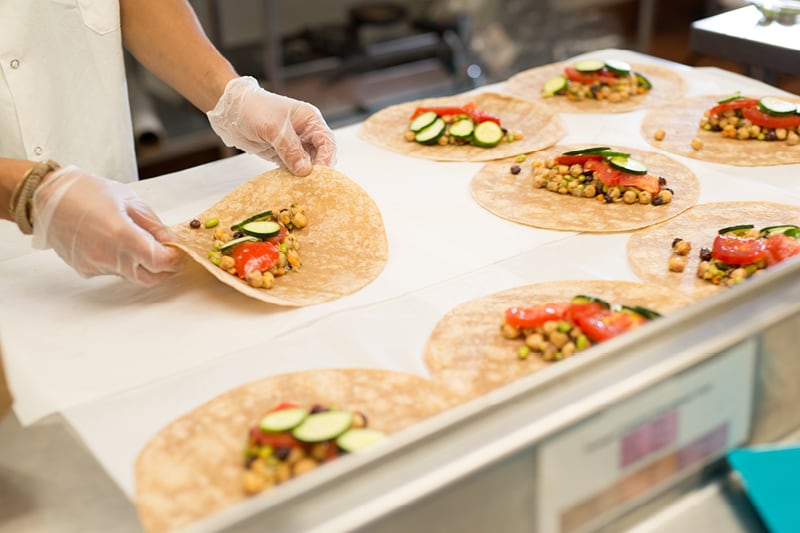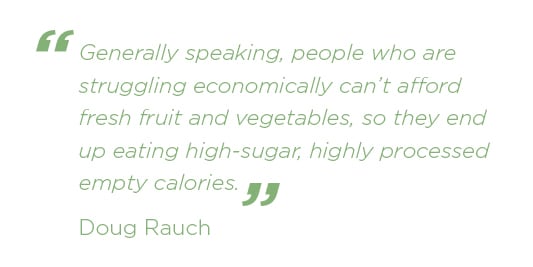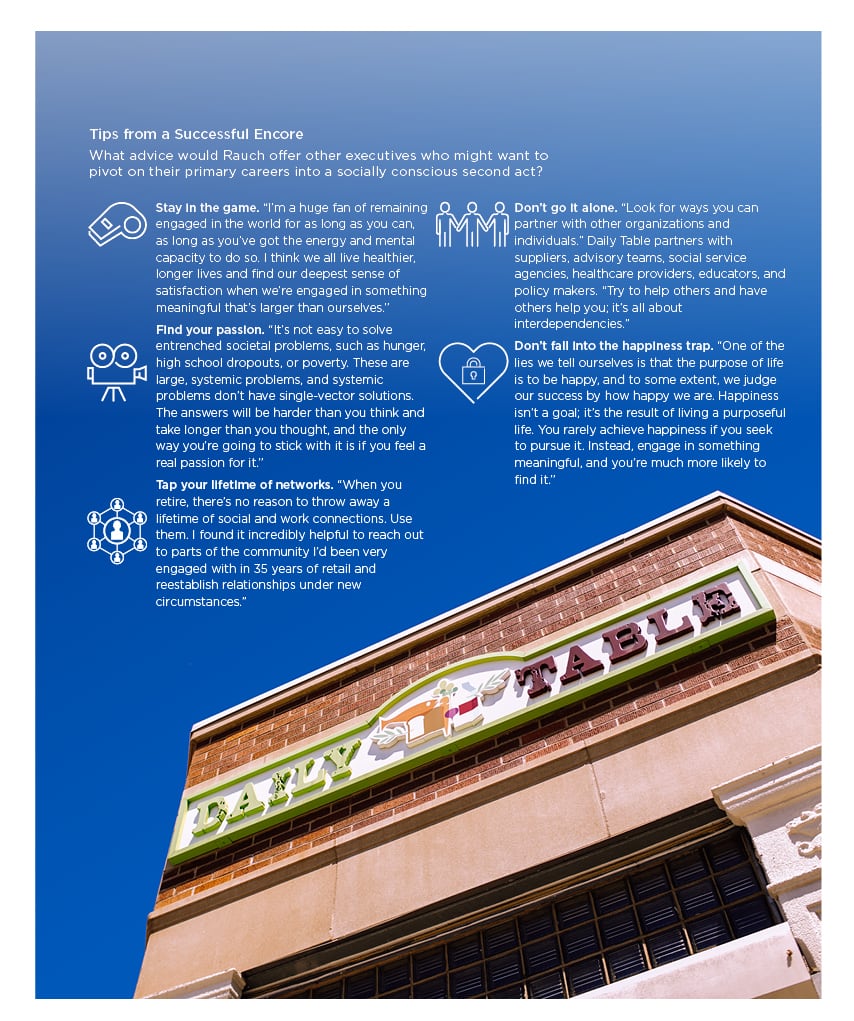Mission for Nutrition
The billboard, sponsored by the Greater Boston Food Bank, said, “One in six Americans are hungry.” Rauch’s first thought was, “That just can’t be right.” As former national president of the Trader Joe’s grocery chain who guided its expansion from nine stores in Southern California to more than 400 stores nationwide, he knew we were in a land of plenty. In fact, from farm to fridge, we waste up to 40 percent of the food we produce, enough to fill the Rose Bowl every day. So why do nearly 50 million Americans struggle to put meals on the table?
“Having spent my career in the food industry, I knew that America had more than enough food to feed everyone,” Rauch says. “So why weren’t we? This started me down the road of discovery about the real nature of hunger in America and what we can do about it.”
That road led him to create the Daily Table grocery stores in the Dorchester and Roxbury neighborhoods of Boston. Daily Table addresses the paradoxical dual challenges of hunger and obesity by providing convenient, healthy, and surprisingly affordable food. “Think of us like a T.J. Maxx or Marshalls for food,” states the nonprofit’s website.
The food is donated or deeply discounted from well-known brands and local growers, national distributors, and nearby retailers. The food could be surplus, approaching expiration date, or imperfect in appearance. It’s food that would otherwise be destined for a landfill.
Now in its fourth year, Daily Table moves about a million nutritional servings a month into the community. That’s a million servings not coming from a vending machine, a convenience store, or a burger griddle. It’s a million steps toward a community’s healthier living, at fast food prices or less.
“Our intention wasn’t to be just a grocery store,” said Rauch. “We are a 501(c)(3) nonprofit because we are dedicated to relieving hunger and food insecurity and raising the community’s health. And we do that by masquerading as a food market.”
The Accidental Grocer

After earning a Bachelor of Arts degree in history and then waiting to hear back about graduate school, Rauch was at a crossroads. A friend who was general manager of the natural food store Erewhon tried to persuade him to come work in his company’s distribution center.
“That didn’t sound very appealing to me,” Rauch recalls. “But this was the ’70s, and the company was filled with bright-eyed, idealistic, optimistic people who were excited about food systems in the world. I thought, wow, this is an interesting group of people.” A stint with this pioneering company would fill the gap until grad school.
But he stayed and became vice president and general manager. “In the process, I started selling Erewhon products through this funny retail chain in Southern California called Trader Joe’s Pronto Market.” At the time, the markets looked like any 7-Eleven, the shelves lined with Wonder Bread, Hostess snacks, Campbell’s soup, soda, and cigarettes.
When Erewhon’s West Coast division was sold, Rauch thought about Trader Joe’s. “I had always loved interacting with the company. They were incredibly available. When I called Trader Joe’s, no one screened the call, asking who’s calling, what’s this in regard to, or is he expecting the call. If [founder] Joe Coulombe was around, someone found him and put him on the phone. I really liked that.”
This was 1977, and Trader Joe’s needed a new raison d’être. Competing with 7-Eleven was not the way forward. One differentiator was that Trader Joe’s had a successful private-label wine business, offering its own Charles Shaw wines for $1.99—“two-buck Chuck”—compared to other popular wines at $5, $6, or $7 a bottle. That model was working. Alcohol sales far surpassed food sales.
Why not do the same for food? “I spent the next year or two working with Joe to formulate the private-label program at Trader Joe’s, basically reinventing how customers think about store brands,” said Rauch. “Up until that point, ‘private label’ was just a price point, cheaper and lower quality than national brands. We turned that around and started creating destination products that were distinctive, unique, or priced significantly lower than the national brand.” The concept worked. Within 10 years, food revenues surpassed alcohol, and Trader Joe’s was poised to become a wildly successful grocery chain.
“I woke up one morning, and I had been with the company about 12 years, and I suddenly realized this is my career,” Rauch recalls with a chuckle. “I was kind of doing this while waiting to figure out what to do with my life. Suddenly I realized, I’m a grocer. How did that happen? It is a great place, with great people, very entrepreneurial, very innovative. It was a really fun, engaging, exciting place to work. Still is.”

Nudged by Coulombe, who was a big fan of business guru Peter Drucker, Rauch got his Executive Master of Business Administration degree at nearby Claremont Graduate University. “When I graduated from Drucker School of Management, the executive team at Trader Joe’s said, ‘You’re the new smarty pants business guy. You’re going to write the business plan for how we’ll grow outside of California.’”
The rest is a case study of which MBA students dream. Between 1990 and 2001, the number of stores quintupled, and profits soared tenfold. In 2008, Trader Joe’s had the highest sales per square foot of any grocer in the country, according to BusinessWeek. At the same time, Ethisphere magazine listed Trader Joe’s among its most ethical companies in the U.S.
But for Rauch, it was the right time for a change.
Graduating, Not Retiring
“It was 2008; I was 56, soon to be 57, and I had been traveling extensively with Trader Joe’s, particularly with all the expansions, opening up all the new stores,” said Rauch. “And, frankly, I wasn’t having the fun I was having before. It was a very different business. I remember going to Minneapolis in January, when it was minus 10 degrees, to look at a patch of dirt that was going to be a new store. I thought, ‘This isn’t fun.’ The ceaseless travel and the management side of the business lost its appeal for me.”
According to Rauch, the puzzles and challenges of creating a private-label program, nurturing a distinctive culture and product portfolio, scaling a nine-store chain to compete with behemoths such as Ralphs and Vons—those things were heady, but now it was time for something else.
“I didn’t know what that looked like. I had no idea what I was going to do,” said Rauch. “But I wasn’t going to call it retirement.”
Rauch spent the next year and a half doing some consulting, serving on boards and as a trustee for the top-ranked Olin College of Engineering. “Pretty quickly, I determined I wasn’t going to be satisfied just sitting on boards. A lot of it is just not as operationally satisfying for someone who had spent his life as an operator.”
An Encore Career for Social Good
A colleague at Olin told Rauch about a new Advanced Leadership Initiative at Harvard. Distinguished business professor and author Rosabeth Moss Kanter had created a program to help leaders at the top of their fields apply their skills to national and global social issues in their next life stage, particularly relating to health and welfare, children, and the environment. The first session was underway. A Boston Globe article sealed the deal for Rauch. This was the next step.
“What attracted me was the concept of taking people who had completed their primary careers but still had gas in the tank—10 to 15 years or longer to still be actively engaged—and let them have the use of the college, all the schools, working with faculty and students—to figure out how to tackle some major social ills,” said Rauch. “Then it hit me. This isn’t about learning, this is about doing. This is about taking your lifetime experience and adding some knowledge and information to social enterprise.”

Then came the billboard—one in six Americans hungry in a land of plenty, including plenty of waste. Rauch reflected on our dysfunctional food culture.
Earlier generations had experienced food scarcity through economic depressions, wartimes, and crop failures in the era before electricity and refrigeration. Baby boomers could be the first generation that took abundance for granted.
“At first I was thinking, it’s just a distribution issue, a logistical question. I thought I could help with that, but it turned out it wasn’t that. You’d better really understand what the problem is if you’re trying to solve it. Otherwise you’re going to come up with some elegant and beautiful solutions to the wrong problem,” says Rauch.
Nutrition with Dignity
“Generally speaking, people who are struggling economically can’t afford fresh fruit and vegetables, so they end up eating high-sugar, highly processed empty calories—junk food, if you will,” says Rauch. “So, the solution isn’t what I thought it was. It isn’t about distribution bottlenecks. They’ve already got a full stomach. We’ve got to get them a healthy meal.”
“That turns out to be complicated, because low-value calories such as corn and high fructose corn syrup are cheap. Nutrients are expensive. So, the question became, how can we afford to provide fruits and vegetables in an economically viable manner?”
Why not launch a massive fundraising effort and create another food bank? Food banks fill a critical need. For instance, Feeding America—the third-largest U.S. charity—feeds more than 46 million people through its vast network of food pantries, soup kitchens, shelters, and other community-based agencies.
However, a Feeding America leader told Rauch that many people who qualify for food charities don’t use them. Why? Is it transportation, immigration concerns, or language barriers?
“It turns out it’s much simpler than that. They’re ashamed, embarrassed. They don’t want a handout. That was a big awakening. Many people would rather keep their dignity than their health. I realized if we’re going to solve this problem at scale, we had to come up with a way that the person in need has a dignified exchange,” says Rauch.
“A handout sets up an imbalance,” says Rauch. “If we’re selling the product, even if it’s for pennies on the dollar, people are going to interact with us in a very different way. In that dynamic, they hold the power of the purse; they end up, by definition, having a sense of agency and dignity.”

Friendly Retail Stores
The Dorchester Daily Table store opened in June 2015, followed by a second location in nearby Roxbury. Membership is free, and Daily Table currently has 42,000 members. Rauch is scouting for third and fourth locations—and eyeing expansion into other states.
The stores offer an upbeat, clean, and friendly retail environment. Hand-lettered signs add a vintage market feel. The aisles and crates are brimming with fresh, healthy food options at budget-friendly prices: a pound of bananas for 29 cents, a can of tuna for 55 cents, or a dozen eggs for $1.19.
Instead of a burger and fries, busy customers can choose a nutritionist-approved dinner of two pieces of chicken, brown rice, and vegetables for $1.99 or pick up ready-to-cook and grab-n-go prepared meals. A teaching kitchen offers free cooking classes several days a week. More than 100 educational modules show members how to have food be tasty, nutritious, and healing.
“I don’t think you’ll find any place in Massachusetts where you can get a prepared meal with the recommended nutritional values for $1.99,” said Rauch. “It’s made possible because Daily Table works with a broad network of suppliers who offer donations and special buying opportunities. Food that might otherwise go to waste is now crafted into meal options that compete with unhealthy fast food options.”
Nutrition by Design
Rauch worked with a task force of nutritionists to quantify “healthy” to guide food decisions. For the last four years, Daily Table has met or exceeded these guidelines in food prepared in-house and purchased and donated food items. The stores do not even sell soda.
In 2017, the head of the Supplemental Nutrition Assistance Program (SNAP) visited Daily Table along with an entourage of U.S. Department of Agriculture representatives. He declared Daily Table to be one of the only stores where food stamp recipients can get the 2,000 calories a day of nutritious food they should be eating and still have money in their pockets at the end of the month.
“We’re very proud of that, because for us, it’s the litmus test of how well we are meeting our mission of delivering nutrition at an affordable value,” says Rauch.

The Bottom Line
While Rauch would love for Daily Table to be self-sustaining, it does rely on monetary and in-kind donations. “I don’t care if you’re Walmart or Costco, you can’t bend the cost curve enough to have nutritious food compete with junk food. You can’t get fruits and vegetables to be as cheap as sugary, processed food,” says Rauch.
About 20 to 30 percent of merchandise is donated; the rest is purchased at discounts. Daily Table also relies on 200 to 300 hours a week from volunteers working alongside 60 employees hired from the local community who are paid 25 percent more than local minimum wage.
“We cover about two-thirds of our expenses from our own generated revenue, but we hope with more stores—and we are fundraising to open additional stores—we can come close to breaking even,” says Rauch. When the economics are viable, the hope is to expand the mission across the country.